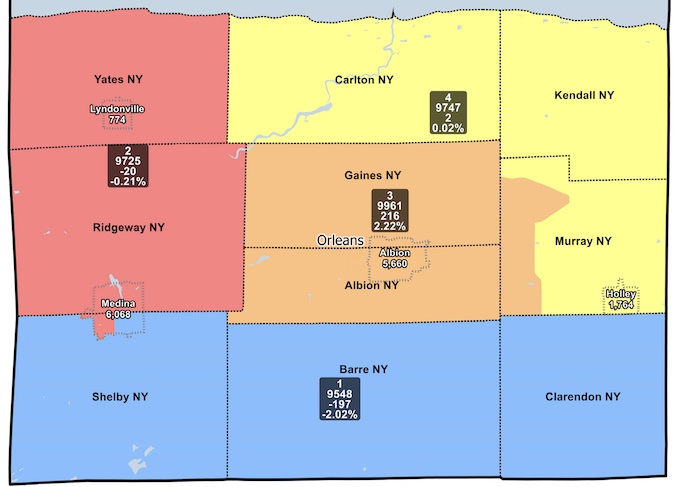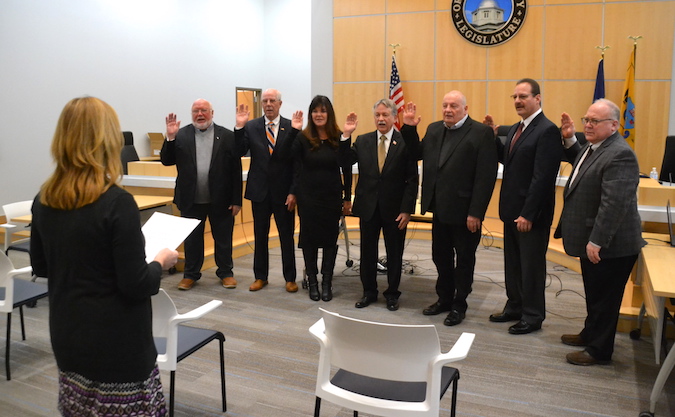Editorial: County Legislature should go to 7 districts, including 1 each for villages of Albion, Medina
The Orleans County Legislature will vote today to do a once-every-10-year tweaking of the four legislative districts.
There won’t be any major shakeups. The Legislature still plans to keep three at-large districts which are elected countywide.
The plan calls for keeping the four legislative districts which are each about 10,000 people. There is some slight shifting to get the four legislative districts within a variance of 5 percent. Some tweaking is needed because the population variance would be an 11.7 percent deviation without changes. That is too much to be legal. (The threshold used to be 10 percent but has been lowered to 5 percent.)
The Legislature started in 1980 following a legal challenge against the previous Board of Supervisors and the principle of “one person, one vote” – that legislators represent districts that are apportioned equally.
The 10 town supervisors used to lead the county government. Some counties still do that, including 2 GLOW counties – Wyoming and Livingston. The towns vary in size so those counties used a weighted-voting system to meet the “one person, one vote” doctrine.
I think it was a good move for the County Legislature to move away from the Board of Supervisors back in 1980. The town supervisors have their hands full leading their towns. It also didn’t seem right to have the county run by the 10 town supervisors and no mayors from the villages.
However, the Legislature has continued to be “town centric” with six of the seven legislators coming from previous roles with town government, either as town supervisors, town councilman, town highway superintendent or a town book keeper. Only Fred Miller, a former Albion village trustee, joined the Legislature after serving on a Village Board.
Miller is also the lone Democrat on the Legislature. The Orleans County Democratic Party has filed a lawsuit in the State Supreme Court, seeking to do away with the at-large positions and seven districts of the same size. Democrats say the current system doesn’t meet the “one person, one vote” standard and also discourages competition, giving Republicans a near-guaranteed victory with the countywide positions. Republicans have a 2-to-1 enrollment advantage in the county.

A redistricting proposal for the County Legislature tweaks the boundaries for the four legislative districts.
Republicans now and back when the Legislature was formed see the at-large as an advantage for residents – that they get to vote for a district legislator and three countywide positions. They actually get to pick a majority of the Legislature. Democrats argue the current system staves off any challengers. In the last election in November 2021, all seven legislators were unopposed.
I’d like to present a different reason for redistricting: We need strong village voices on the Legislature.
The four villages – Albion, Holley, Lyndonville and Medina – account for 14,209 people or 35.2 percent of the county’s total, yet they don’t have much influence on the Legislature.
The villages face big challenges with high poverty rates, vacant homes, shrinking populations, and sky-high tax rates. But those challenges seldom come up in public debate at the county level. A culvert in need of attention in an out-of-the-way spot in the country consumes more passion and money from the current Legislature. They seem to think the villages issues are solely on the villages to resolve.
The Legislature should be redistricted and the villages of Albion and Medina should have their own representative on the body.
The county has 40,343 people, according to the 2020 Census. If that is divided by 7, each district should have 5,763 people. That happens to be very close to the size of the Village of Albion at 5,637 people and the Village of Medina at 6,047 people. If we had two village reps out of seven positions, that would account of 28.6 percent of the Legislature, close to the percentage of village population among the 40,343 total.
The current Legislature hasn’t given the villages (and towns) any more of the sales tax since 2001. Back then, the local sales tax was about $10 million for the year. Last year it totaled $22.5 million.
The county shares $1,366,671 in sales tax with the 10 towns and four villages – $378,777 to the four villages and $987,894 to the towns in 2023.
If the Legislature hadn’t frozen the formula, all the municipalities would have more than doubled their sales tax revenue since 2001.
The Legislature sees the county’s needs – upgraded buildings, roads and infrastructure repair – as top priorities deserving of the full amount of the sales tax increase since 2001. Yet, the village and town needs are seen as less important to the Legislature.
That seven-member body is painfully aloof to the rising tax rates at village level, among the highest in the Finger Lakes region. Those taxes are crushing to the residents, especially younger families and senior citizens. Those rates discourage investment in the villages, and these are the prime spots for businesses which need the village water and sewer services – and their population centers.
The County Legislature seems to cast blame on the villages for their state of affairs, and don’t see the Legislature’s duplicity in driving up the tax rates by hoarding the local sales tax.
Village reps from Medina and Albion would make noise about this situation, rather than the current finger pointing that the village leaders get from the county.

The Village of Albion completed a spray park in June 2021 that has been a big draw for the community. It was part of an $800,000 upgrade at the park on Route 31. The local villages work on quality-of-life issues and essential services despite no increase in the local sales tax since 2001.
If the county agrees to village districts in Albion and Medina, how else should the Legislature look?
With districts about 5,500 to 6,000 people, I would suggest the outside-village portions of Shelby and Ridgeway be in the same district. Together the two towns have 11,505 people. Take out the Village of Medina, and the remainder of those two towns have 5,458 people.
It makes sense to me to have Yates and Carlton in the same district. They are both rural towns along the lake, with many Amish and Mennonite businesses. Together they have 5,402 people.
The towns of Albion and Gaines also should be together. Together they have 10,865 people. Take out the village’s population of 5,637 and the two towns have 5,228 people.
The last two districts aren’t so clear cut. I think it makes sense to have Barre and Clarendon together. They are southern towns in the county, with muckland and wide open spaces. Together they have 5,158 people. I think it makes sense to include about 700 people in the southern part of Murray in this district. About 700 also should be taken from Murray and put in the Albion and Gaines district to bring that one closer to the average.
The last district would have Kendall and the rest of Murray. Kendall has 2,617 people. Murray has 4,796 residents. That’s 7,413 together. But if 1,400 are subtracted (to be included in the Barre-Clarendon district and the Albion-Gaines district) that would put the rest of Murray and Kendall at 6,013.
The county could utilize weighted voting to get the seven districts even closer.
The Legislature will vote at 4:30 p.m. today on its plan to keep the four districts and three at-large. It might not look at redistricting again for about 10 years.
If the redistricting plan passes today, I would encourage the Legislature to look again at having seven districts, and do it in about a year with public hearings around the county. Waiting 10 years is too long for our population and business centers in the village to go without strong advocates on the Legislature.






































































